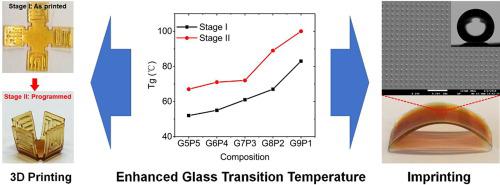Chemical Engineering Journal ( IF 13.3 ) Pub Date : 2021-01-12 , DOI: 10.1016/j.cej.2021.128466 Biao Zhang , Ahmad Serjouei , Yuan-Fang Zhang , Jumiati Wu , Honggeng Li , Dong Wang , Hong Yee Low , Qi Ge

|
We report a dual-stage photocrosslinked polymer network based on sequential ultraviolet (UV)-triggered radical polymerization and thermally activated etherification, applicable to the fabrication of tailorable and programmable high-resolution structures. The first stage involves photoinitiated polymerization of monomer and crosslinker to obtain an intermediate polymer network. As such, sophisticated two-dimensional (2D) and micro-scale three-dimensional (3D) structures can be made by using UV-based advanced manufacturing technologies. These complex structures can then be readily programmed into other desired, permanent shapes, in the second stage, via thermally triggered etherification which results in a highly crosslinked, robust polymer network. The intermediate network (Stage I) is characterized to have a Young’s modulus ranging from 342 to 1146 MPa and a glass transition temperature from 52 °C to 83 °C, depending on the concentration of crosslinker. The same material attains a glass transition temperature ranging from 67 °C to ~105 °C and a Young’s modulus of up to 1607 MPa after the subsequent heating process (Stage II). Originally 3D printed 2D structures can be further programmed into rigid, permanent 2.5/3D ones. Micropatterns fabricated from intrinsically hydrophilic dual-stage crosslinked photopolymers through soft lithography show superhydrophobicity, and can subsequently be molded with different curvatures for practical applications.
中文翻译:

先进制造的双阶段热固性光敏聚合物
我们报告了基于连续紫外线(UV)触发的自由基聚合和热活化醚化的双阶段光交联聚合物网络,适用于制造可定制和可编程的高分辨率结构。第一步涉及单体和交联剂的光引发聚合以获得中间聚合物网络。这样,可以通过使用基于紫外线的先进制造技术来制造复杂的二维(2D)和微型三维(3D)结构。然后,在第二阶段,通过热触发的醚化作用,可以将这些复杂的结构轻松地编程为其他所需的永久形状,从而形成高度交联的坚固的聚合物网络。取决于交联剂的浓度,中间网络(阶段I)的杨氏模量范围为342至1146 MPa,玻璃化转变温度为52°C至83°C。在随后的加热过程(阶段II)之后,相同的材料达到的玻璃化转变温度为67°C至〜105°C,杨氏模量高达1607 MPa。最初的3D打印2D结构可以进一步编程为刚性,永久性的2.5 / 3D结构。由本质上亲水的双级交联光敏聚合物通过软刻蚀制得的微图案具有超疏水性,因此可以在实际应用中模制成不同的曲率。在随后的加热过程(阶段II)之后,相同的材料达到的玻璃化转变温度为67°C至〜105°C,杨氏模量高达1607 MPa。最初的3D打印2D结构可以进一步编程为刚性,永久性的2.5 / 3D结构。由本质上亲水的双级交联光敏聚合物通过软刻蚀制得的微图案具有超疏水性,因此可以在实际应用中模制成不同的曲率。在随后的加热过程(阶段II)之后,相同的材料达到的玻璃化转变温度为67°C至〜105°C,杨氏模量高达1607 MPa。最初的3D打印2D结构可以进一步编程为刚性,永久性的2.5 / 3D结构。由本质上亲水的双级交联光敏聚合物通过软刻蚀制得的微图案具有超疏水性,因此可以在实际应用中模制成不同的曲率。











































 京公网安备 11010802027423号
京公网安备 11010802027423号